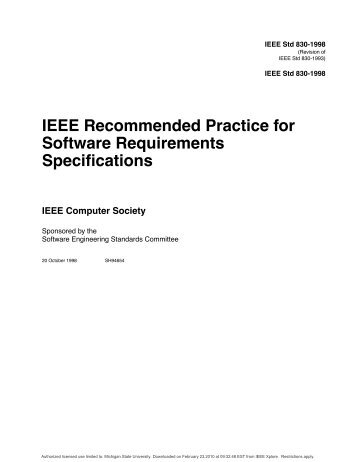Ieee Software Architecture Document Template

Contents. Overview IEEE 1471 is the short name for a standard formally known as ANSI/IEEE 1471-2000, Recommended Practice for Architecture Description of Software-Intensive Systems.
Within (IEEE) parlance, this is a 'recommended practice', the least normative of its standards. In 2007 this standard was adopted by JTC1/SC7 as, Systems and Software Engineering - Recommended practice for architectural description of software-intensive systems. It has long been recognized that “architecture” has a strong influence over the life cycle of a system. However, until relatively recentlyhardware issues have tended to dominate architectural thinking, and software aspects, when considered at all, were often the first to be compromised under the pressures of development.
[IEEE 00, pg. It prescribes a standard organization (template). Documenting Software Architecture: Documenting Interfaces (S).
IEEE 1471 was created to provide a basis for thinking about the architecture of software-intensive systems. IEEE 1471's contributions can be summarised as follows (in this list, items in italics are terms defined by and used in the standard):. It provides definitions and a for the description of. It states that an architecture should address a system's concerns.
Electronic Arts. Apr 03, 2014 PC Game Def Jam Fight - For New York Free Download, Def Jam Fight - For New York Full Version PC Game Download, Highly compressed PC Game Def Jam Fight. Download Game Def Jam Fight For New York Full Verson Gratis Your Blog Description here! Download Game Bully Schoralship Edition Highly Compressed Game PC.
It asserts that architecture descriptions are inherently, no single view adequately captures all stakeholder concerns. It specifies the notions of and, where a viewpoint identifies the set of concerns and the representations/ modeling techniques, etc. Used to describe the architecture to address those concerns and a view is the result of applying a viewpoint to a particular system. It establishes content requirements for architecture descriptions and the idea that a conforming architecture description has a 1-to-1 correspondence between its viewpoints and its views. It provides guidance for capturing architecture rationale and identifying inconsistencies/unresolved issues between the views within an architecture description IEEE 1471 provides informative annexes that relate its concepts ito architecture concepts in other standards, including and.
History In August 1995, the IEEE Software Engineering Standards Committee (SESC) chartered an IEEE Architecture Planning Group (APG) to set direction for incorporating architectural thinking into IEEE standards. In April 1996, the Architecture Working Group (AWG) was created to implement the recommendations made by APG to the SESC. The AWG was chaired by Basil Sherlund, vice-chairs Ronald Wade, David Emery, the specification was edited by Rich Hilliard.
Len Bass
The AWG had 25 members. Drafts of the specification were balloted and commented on by 130 international reviewers. In September 2000, the IEEE-SA Standards Board approved the specification as IEEE Std 1471-2000. In 2006, ISO/IEC Joint Technical Committee 1 (JTC1), Information technology/Subcommittee SC 7, Software and systems engineering, adopted the specification as ISO/IEC 42010, under a special “fast-track procedure”, in parallel with its approval by national bodies of ISO and IEC. A coordinated revision of this standard by ISO/IEC JTC1/SC7/WG42 and IEEE CS commenced in 2006, following the successful ISO/IEC fast-track ballot and in line with the IEEE standard 5-year review of the standard. In November 2011, IEEE 1471-2000 and ISO/IEC was superseded by, Systems and software engineering — Architecture description.